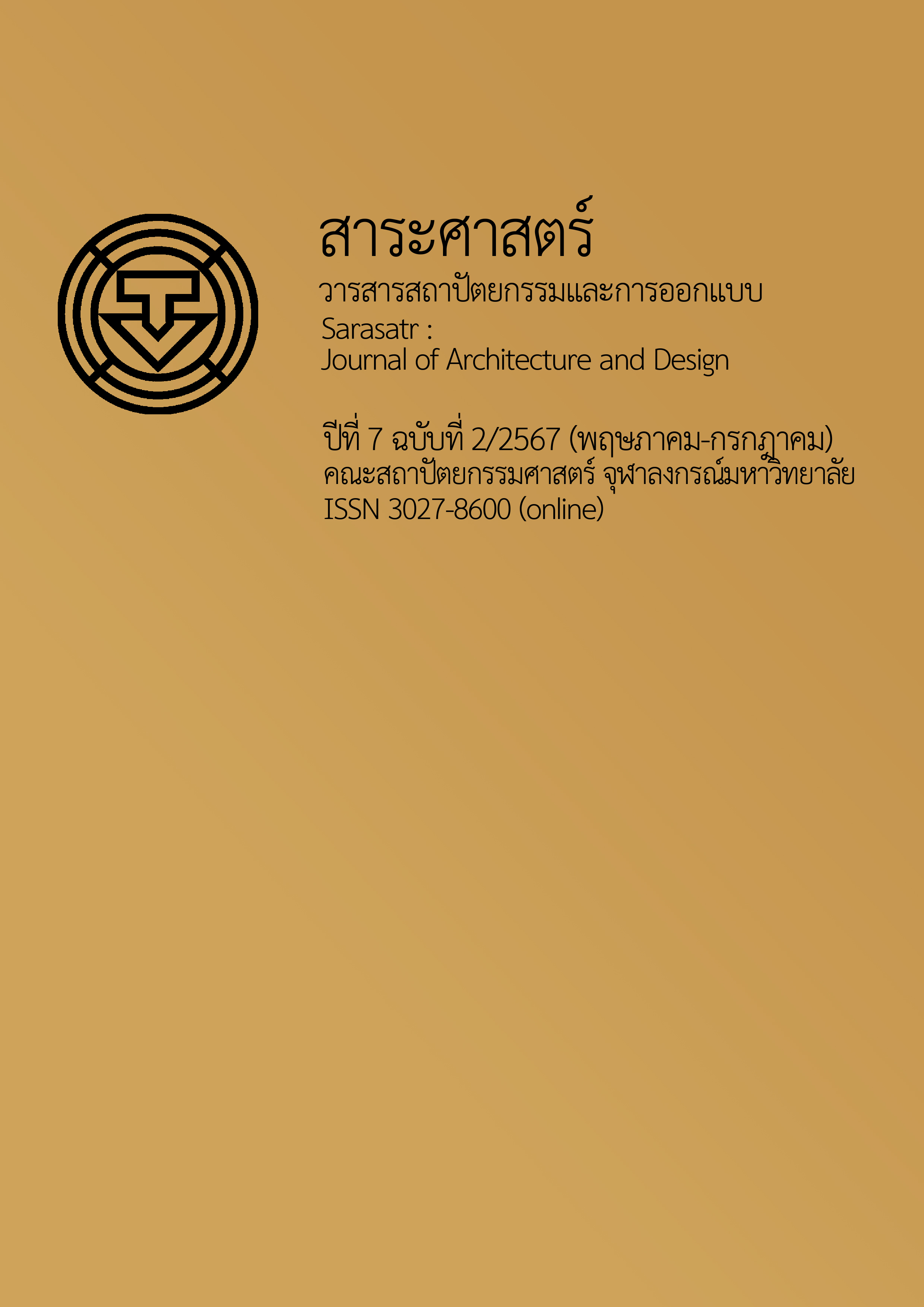Management Model of Cleaning Services Personnel according to the Terms of Reference (TOR) for Government Healthcare Facility Cleaning Contracts
Main Article Content
Abstract
Important factors leading to the standardization of cleaning service contracts in hospital buildings include the number of personnel. This must be specified in the Terms of Reference (TOR) to ensure mutual understanding between the contracting parties. Therefore, this research aims to study the principles and analyze the methods for organizing cleaning personnel in government hospital buildings. The study involves examining the TORs of 13 projects and interviewing 18 relevant stakeholders.
Based on the study, it was found that the building area (in square meters) is a key factor in determining the number of cleaning personnel. It can be identified into three patterns which are firstly, the detailed project specifications, specifying positions, the number of cleaning personnel, wages, area names, responsible area sizes, clear working days and times (divided into morning, afternoon, and night shifts), as well as the quantity and specifications of various materials and equipment. Work standards according to clearly defined plans were outlined. There were five projects following this pattern. Secondly, the moderate-level project specifications, detailing the number of cleaning personnel and the responsible buildings, but not specifying area names, working days, or work standards. Materials and equipment were provided sufficiently for use without specifying quantities and specifications. There were three projects that followed this pattern. Lastly, the minimal-level project specifications, specifying only the number of cleaning personnel and the overall building area. Other factors were left for the contractor to manage independently. There were five projects following this pattern. Due to the lack of detail in the case study project specifications, especially regarding significant factors, it resulted in unclear staffing patterns. Therefore, it is necessary to comprehensively define these factors to establish a consistent standard.
The research findings indicate that among the 13 case studies conducted in state-run hospitals, key factors include the total building area (in square meters), workspace area, number of personnel, and area of responsibility. These factors are essential for determining the staffing requirements, aligning with the research of Peters et al. (2018). However, the project specifications lack comprehensive data, particularly on crucial factors, which is vulnerable but essential for proposing efficient projects. Consequently, this variance affects the standards of operational practices.
Article Details
References
กรมการปกครอง. กองการเจ้าหน้าที่. กลุ่มงานวางแผนอัตรากำลังและพัฒนาระบบงาน. (2560). คู่มือการจ้างเหมาบริการ. http://www.hinkhon.go.th/hinkhon/mainfile/5yrfbg8kt
กองบรรณาธิการนิตยสาร Builder. (2014). การบริหารจัดการอาคารสถานที่ facility management. https://www.buildernews.in.th/archdesign-cate/facility-management/9315
Sustainable Development Goal Move. (2565). SDG vocab | 22 – labor-intensive – แรงงานเข้มข้น. SDG Move. https://www.sdgmove.com/2021/06/24/sdg-vocab-22-labour-intensive/
ณิชา วิริยานนท์. (2557). การจัดการงานรักษาความสะอาดศูนย์การค้า : ผลการศึกษา 5 กรณีศึกษาในกรุงเทพมหานคร [วิทยานิพนธ์ปริญญามหาบัณฑิต ไม่ได้ตีพิมพ์]. จุฬาลงกรณ์มหาวิทยาลัย.
ธงชัย ทองมา. (2565). BFM 2122 การบริหารทรัพยากรอาคาร 1. https://elfit.ssru.ac.th/thongchai_th/pluginfile.php/27/block_html/content/EP2
ธนโชติ ฤทัยธง. (2558). การจัดการงานรักษาความสะอาด คอมมูนิตี้ มอลล์ [วิทยานิพนธ์ปริญญามหาบัณฑิต ไม่ได้ตีพิมพ์]. จุฬาลงกรณ์มหาวิทยาลัย.
บัณฑิต จุลาสัย และเสริชย์ โชติพานิช. (2547). การบริหารทรัพยากรธรรมชาติ. โรงพิมพ์แห่งจุฬาลงกรณ์มหาวิทยาลัย.
พัทธนันท์ ชมภูวัง, ชนินทร์ วิชชุลตา, อนิรุทธิ์ ผ่องแผ้ว, ศิริกัญญา ทำมามรุ่งเรือง, และธานัฐ ภัทรภาคย์. (2565). ปัจจัยที่มีผลต่อประสิทธิภาพการปฏิบัติงานของพนักงานทำความสะอาด บริษัท รักษาความปลอดภัย พีซีเอสและฟาซิลิตี้ เซอร์วิสเซส จำกัด. วารสารรัชต์ภาคย์, 16(44), 328-337.
ระเบียบกระทรวงการคลัง ว่าด้วยการจัดซื้อจัดจ้างและการบริหารพัสดุภาครัฐ พ.ศ. ๒๕๖๐. (2560, 23 สิงหาคม). ราชกิจจานุเบกษา. เล่ม 134 ตอนพิเศษ 210 งหน้า 1-71.
วิรุจน์ สมโสภณ. (2550). แนวทางการวัดผลการปฏิบัติงานการบริหารทรัพยากรกายภาพ [วิทยานิพนธ์ปริญญาหาบัณฑิต, จุฬาลงกรณ์มหาวิทยาลัย]. CUIR. https://cuir.car.chula.ac.th/handle/123456789/32531
ศรีสุดา โพธิ์สว่าง. (2556). ผลการพัฒนาระบบงานดูแลรักษาความสะอาด (CQI). https://sriwilaihos.moph.go.th/home/images/stories/HA/3cqi.pdf
สาคร สุขศรีวงศ์. (2550). การจัดการจากมุมมองนักบริหาร. จี พี ไซเบอร์พรินท.
เสริชย์ โชติพานิช. (2541). การบริหารจัดการทรัพยากรอาคารสถานที่. วารสารสถาปัตยกรรมของสมาคมสถาปนิกสยามในพระบรมราชูปถัมภ์ (อาษา), 3(41), 50-60.
เสริชย์ โชติพานิช. (2553). การบริหารทรัพยากรกายภาพ : หลักการและทฤษฎี. โรงพิมพ์แห่งจุฬาลงกรณ์มหาวิทยาลัย.
Cotts, D. G., Roper, K. O., & Payant, R. P. (2009). The Facility management handbook (3rd ed.). American Management Association.
Keeling, B. L., & Kallaus, N. F. (1996). Administrative office management (11th ed.). South-Western Education.
Millet, J. D. (1954). Management in the public service: The quest for effective performance. McGraw-Hill.
Peters, A., Otter, J., Moldovan, A., Parneix, P., Voss, A., & Pittet, D. (2018). Keeping hospitals clean and safe without breaking the bank; summary of the Healthcare Cleaning Forum 2018. Antimicrobial Resistance and Infection Control, 7(132), 3. https://doi.org/10.1186/s13756-018-0420-3
Sarla, G. S. (2023). Cleaning and maintenance services within a hospital setting: Environmental support services. Research & Reviews: A Journal of Toxicology, 13(3), 1-3. https://doi.org/10.37591/rrjot.v13i3.3360
SNV Nepal. (2021). Standard operating procedures (SOPs) for WASH in schools. https://a.storyblok.com/f/191310/5a45ea4553/2021-nepal-sops-wash-in-schools-snv.pdf
Thongchom, J. (2017). Vocabulary about evaluation. http://www.gotoknow.or


